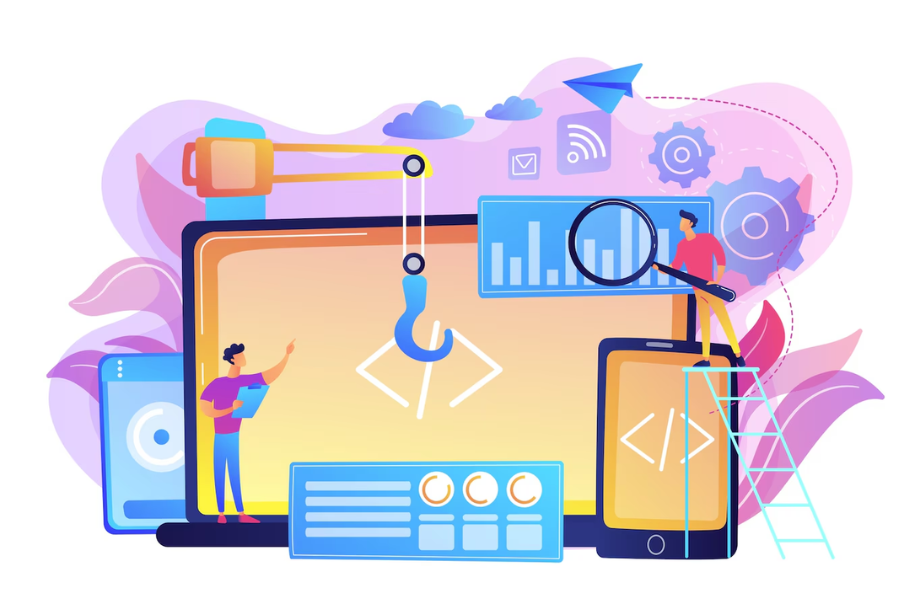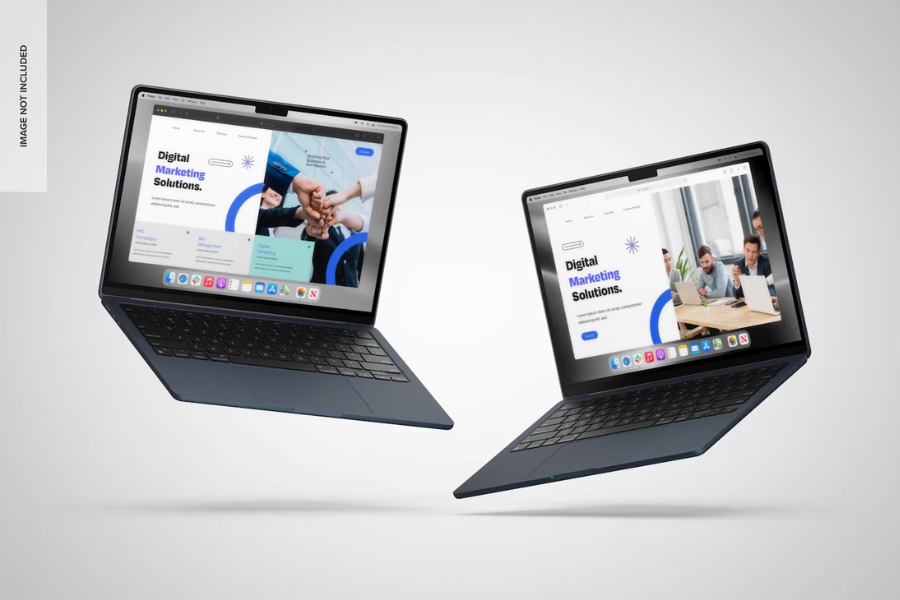A headless ecommerce platform is a rising trend in ecommerce that can improve the overall digital presence of your business. It can also assist businesses in satisfying the always-changing demand of today’s buyers. Notably, online shops that use a headless commerce architecture contribute to the innovation of the ecommerce industry.
This article further discusses the nature of headless ecommerce solutions and their benefits; how they are better than the traditional ecommerce model; some of the best headless ecommerce platforms; and when to use this ecommerce system.

freepik
What is a headless ecommerce platform?
A headless commerce platform is a solution that separates the front-end and back-end of an ecommerce website.
Definition and Introduction to headless ecommerce
The ‘head’ part refers to the front end that guests engage with, such as the e-shop design and display layer.
What we mean by headless ecommerce business is that the front end is decoupled from the back end – the server side of the e-shop that handles operational tasks.
Comparison with traditional ecommerce platforms
The traditional ecommerce platform observes a centralized system, integrating both front-end and back-end tools to allow alterations to your e-store while not separating services. That can be useful, but it also has some limitations.
By having the two sides interconnected, they also become interdependent. Should any changes be made on one side, they may affect the other, potentially leading to lower flexibility and speed than headless models. Plus, in most cases, you would use a platform that primarily relies on pre-built integrations, applications, and functionalities not have viable options for tailoring.
Traditional ecommerce platforms were legacy ecommerce platforms years ago, and they are still preferred due to their approachability in terms of the special skills necessary. You ought to be aware of your business logic before opting for a traditional ecommerce model or a headless one.

freepik
How does a headless ecommerce platform work?
In a headless e-shop solution, you have a decoupled commerce system and content management system (CMS).
Decoupled architecture and separation of front-end and back-end
The decoupled approach is equivalent to dividing the pairs of websites – front-end and back-end. As such, it is needed to observe the gap between the constituents of each.
A headless content management system (abbr. Headless CMS) and a headless commerce solution are a pair of individual sections – customer-facing (front-end) and internal functionality (server-side). These constitute the headless architecture of an e-store.
When we studied each on its own, we saw that a headless ecommerce system provides the required infrastructure for online selling, but it does not dictate how the display should be built or revealed. That is the duty of the headless Content Management System, which is devised to oversee and deliver content on a front-end presentation layer or, in layman’s terms, multiple channels that are visible to and easily available to shoppers.
In other words, front-end developers and back-end developers work together to make certain that the visual and the behind-the-scenes side of the e-shop or mobile app operate seamlessly. That way, the engineering team has complete control over the online store, and to that extent, you have complete creative control over what you wish for it to resemble or function like.
API-driven system and versatility
In the headless commerce system, the front and back ends are independent components sharing data through an Application Programming Interface, which acts as a link between them. In this fashion, user interface engineers can employ any available tool as long as they can integrate it with the server side through an API.
API (Application Programming Interface) is a set of rules and protocols that define how software applications exchange information and interact with each other.
There are different types of APIs, centered on their purpose and usage, such as web (ex. HTTP), service (ex. Twitter, Facebook), library, and operating system (ex. Linux, Microsoft). All of those make transferring data possible in various formats by exchanging requests and responses, making the platform effective.
Businesses that utilize API properly have great versatility in developing e-stores and native mobile apps. In addition to the core capabilities, they can integrate into the back-end commerce engine, insert extra properties to improve the customer experience, and deliver content across multiple touchpoints – separate outlets (e-shop, web app, etc.) and interfaces shoppers can engage with.
Content delivery network (CDN) and Caching
Another component is content delivery networks (CDN) – globally spread service systems that operate together to offer quick content delivery.
The delivery network stores a duplicate of the e-store’s pages – a process called caching – so that the load on the main server can be reduced and site performance can be improved. This is especially useful for users far from the main server’s location.
CDN caching should not be confused with your browser’s caching, which occurs when you open a website by storing cache files on your device. Headless e-store application CDN caching decreases the general loading pace of e-store pages, and local browser caching reduces them even further.
Advantages of headless infrastructure for ecommerce
If you settle for a decoupled model for your e-store, you will definitely enjoy several positives. Since the side customers see and the infrastructure end are separated, this allows you to quickly make your website into what customers want. Let’s see more of that below:
Greater freedom and personalization options
Of course, you want to give your customers a positive experience and one that they will never forget. Since the front-end and back-end operate distinctly, ecommerce stores have a lot more control in tailoring the user interface and bettering the user experience. They can do these without worrying about affecting back-end operations.
This liberty also extends to third-party integrations, which enable the usage of specialized services to better their website’s ecommerce functionality. Ultimately, all of that results in more opportunities to innovate and differentiate oneself in the already saturated online market.
Improved performance and scalability
The decoupled nature of decoupled platforms allows for independent scaling of both the front-end and back-end. Even if the site visits increase suddenly (as it tend to do around holidays and Black Friday), the system won’t be overwhelmed.
Earlier, we mentioned APIs, CDNs, and caching – these are some of the elements that contribute to faster load times and smoother user experience.
Streamlined integration with third-party services
A further instance of the benefits of headless ecommerce platforms is the capacity to integrate third-party services not having much friction.
In doing so, companies can áccess several independent platforms, such as Product Information Management (PIM), CRM, ERP, etc. All of them essentially serve to leave no holes in the processes of the complete online shopping experience.

freepik
Simple content delivery and management
The decoupled e-shop makes it quick to supervise and distribute content from the back end to the front end.
Firms can administer their content via the back end and push it to the front end, which could be a website, a mobile app, or an IoT device, not forgetting the Virtual Reality (VR) interaction.
A competency such as that makes certain of cohesive distribution of content throughout all outlets, contributing to a more cohesive brand reputation and, to that extent, more positive interaction for consumers.
Better mobile responsiveness and user experience
The headless approach makes it easier to develop an optimized platform for mobile that does not deviate from the desktop version in terms of experience for shoppers. This framework further aids the development of progressive web apps, which behave similarly to an Indigenous application for mobile, but are accessed via an internet browser.
When customers know how to navigate and not have to go through the learning process twice (as short as it may be), they have a better time. In some cases, this could be the fine line between having a lead and having a client.
More sales and lower costs
With a decoupled online store you can test quickly for new features. To better put it, you can improve the quality of your store quickly which can yield more sales. A smooth experience for customers gives you a higher chance of converting them.
Besides, the separation fo the two main parts of the store makes it simple to update and maintain your e-store at a cheaper rate. You can update one side without choosing to update the other.
Drawbacks of Headless Ecommerce
As you’ve seen the upsides of headless ecommerce, you should also be aware of the downsides:
- Super Complex: Implementing front-end and backend systems that are apart, is not as straightforward as it sounds. It would demand you to use some technical skills or seek the help of a professional to step up. We also discussed concepts like APIs and caching earlier all of these can be more difficult than they appear.
- High Starting Costs: Yes, we said it is cheaper to maintain and update this ecommerce system but at the beginning, expect that the charge will be on the high side. Think of the custom integration and the need for an expert or someone to consult. These costs accumulate pretty quickly.
- Slow Building Process: Separating display from operation comes with a consequence of time. It takes longer to deploy which affects the time for site launch and marketing.
- Maintenance and Support: It is tougher to service the components of the headless ecommerce system because a particular change on one end may require modification on the other. We have to ensure that all components work well together and this takes a longer time.
- Interaction Issues: It can be tough to maintain a cohesive shopping experience for buyers through this system as it’s not that simple to sync content on both the display and back end.
Last, but not least, it requires some time to carefully plan the management of scaling with the decoupled system even though it supports growth. Not properly handling this can lead to issues.
Use cases and examples of headless e-shops.
Numerous firms have leveraged the capabilities of headless commerce solutions to make their virtual presence known in a more differentiated manner and deliver the authentic shopper experience they aim for.
Big-scale enterprise e-stores
The larger ecommerce businesses are, the more complex the processes and the more elastic the approaches tend to be.
As a versatile strategy for ventures with massive online stores, the best headless ecommerce platforms make the supervision of massive product catalogs much more feasible while serving a global audience.
Example: A good example of a decoupled e-shop in this category is that of Best Buy, which takes advantage of this framework to track its huge catalog and global sales. The team can give shoppers a positive experience with their responsive e-store while managing their stocks and order processing thanks to the back end.
Multi-channel ecommerce experiences
A coherent brand presence is necessary to give buyers a wholesome experience at all customer touchpoints.
The detached system permits companies to apply one back-end to deliver content across multiple customer touchpoints, no matter their display end.
Example: If you have a digital shop and ápp for smartphones, the decoupled online retail encourages you to supervise promotion info, product description, and customer details via only one backend. In this fashion, you only need to make updates behind the scenes and it will show at every contact point (web store, smartphone app) instantly. Customers will enjoy a consistent experience through this means.
Adaptable product plans
With the visual side freed from the shortcomings of the back end, headless e-shops can build exclusive screens that facilitate consumer adjustments to products and services. This way they get a more engaging retail experience.
In this regard, composable commerce becomes more achievable. It’s a concept where companies can compose a tailored digital commerce solution by mixing best-of-breed services and applications instead of sticking to only one platform.
The back end is also more adaptable thanks to this decoupled architecture. You can perform various operations and tests without directly influencing the front end and improve your marketing team’s features, such as inventory management to track the available number of units of your products.
Example: Think about it this way, when you visit a store, you expect to choose the color of the product you want. For example, if you like white earbuds or even clothes, you should be able to choose the white color. But the headless online retail store allows you to add even more details to the earbuds you want. If you would like a white and noise canceling earpad and it is available —- mystery solved!

freepik
Innovative user experiences and interfaces
Empowering businesses through innovation is one of the most important use cases of headless platforms because, with its help, it’s easier to try out new user interfaces and build fresh user experiences.
From a technical standpoint, it’s also possible to create interactive product demonstrations and even virtual reality shopping experiences without the constraints of traditional, coupled digital commerce models.
Example: Although the headless framework is technical to set up, it has loads of perks, like giving customers a virtual reality experience. If you dont have a VR headset at home, your retailer might provide an internet-driven immersive experience without using the headset but using a 360-degree simulation.
Selecting the accurate headless solution for your company
Several factors can influence your decision as to picking the best-decoupled system for your firm. While selecting, these below phases may help you.
Evaluating your company’s demands and necessities
The first step to any progressive shift as a firm is to crosscheck your enterprise’s demands and ambitions. Kick off by highlighting your temporary and bigger goals.
For instance, do you desire to improve your online user experience or expand to new markets? You may simply only demand more sales. In that case, it may not just be up to the platform you are using, but other factors such as your marketing funnel.
Having objectives plays a significant role in guiding your final decision. Furthermore, other factors may not be as relevant if you already own a large online store. Most of all, consider if you have an in-house team of backend and frontend developers who can manage and maintain a headless system or if you need to invest in hiring such individuals first.
Comparing available decoupled ecommerce platforms
Once you know your business goals and needs, your next step is to evaluate whether the available platforms will fulfill them. Research the most popular options, and see if one matches your desires.
Take into account their core offerings, what features make them stand out unique features, and social proof. Additionally, pay close attention to the visual display of the platforms. Do you think you can navigate it on your own or how much assistance would you need from observing the interface in the demo or free version? However don’t forget the infrastructure side, it should be easy for you to navigate to an extent.
Think about it this way – the ideal choice would meet your needs while also giving you additional power features that you can use to develop and maintain your store.
Assessing scalability and flexibility
Crucial considerations of every ecommerce business are the growth potential and how the chosen headless platform can support that.
When it comes to scalability, you should look for a stable option that could handle a spike in traffic and transactions without impacting operations. As for flexibility, you need the freedom to build whatever front-end you wish to represent your brand and give the best user experience.
Since headless models rely on API first and foremost, most platforms you check out will be similar. However, it would be best if you spent time verifying which strikes the best balance between price, scalability, and flexibility. You can even make an official inquiry and see what offers you would get and how your customer experience would feel.

freepik
Analyzing integration and development capabilities
From a development perspective, you need to assess the coding requirements of each platform so that you know to what extent you can rely on the possibilities during development and the kinds of integrations that can be made efficiently.
Not all platforms require a high level of coding knowledge, but not all offer out-of-the-box solutions. This is where the development team you have gathered will play a key role because, depending on their abilities, you may wish to go with one option over the other.
To that end, when you already know what kind of business systems you will use for CRM, ERP, PIM, payment gateways, and so on, you can better assess the integration capabilities as well. Pre-built integrations generally come with most platforms, though you need to develop custom integrations in some cases when what you need is not on the list.
Considering budget and resources
Throughout the process, you must be aware of your budget and resource constraints. Headless ecommerce technology varies in price, sometimes significantly, so before you commit to one, you need to know the total cost of ownership.
The total cost includes licensing and subscription fees and costs for implementation, maintenance, and potential future upgrades. That’s where the long-term and short-term planning from step 1 comes into play – as long as you know the direction you are headed in and can project accurate numbers, you can make a well-informed decision.
The earlier-mentioned resources, such as technical staff, must be accounted for during this step. Some benefit more from in-house talent, while others prefer outsourcing.
The more expensive the platform, the more features it usually has. Cheaper plans generally have limited functionalities. The best way to balance your budget and resources with your business needs and goals is to inquire directly.
For instance, if you send an inquiry to NEXT BASKET, you will quickly notice that there are no one-fits-all plans but, instead, custom-tailored plans that are appropriate to the specificity of the business.
Those who need full support for their online store and just wish to manage their brick-and-mortar ones; those who want a helping hand but not with everything – whichever type of business yours is, we are confident we can point you in the right direction and accommodate your needs.
Closing and Call to Action
If you were to start seeing a change in your business right now, then a new headless online store might not be the best pick because of the time and resources it takes to set up. Except you have it set already.
If you haven’t, this guide is perfect for guiding you to get started and if you already have a store running it is also great for highlighting advantages you didn’t know before now. That said, you must have some patience and think long-term to see maximum results.
On the brighter side, we at NEXT BASKET can offer consultation and technical advice if you are looking to opt for headless digital commerce.
Frequently asked questions
What is the difference between headless and traditional ecommerce platforms?
In traditional online retail stores, the front-end and back-end intertwine and have a direct influence on each other making it a connected or coupled architecture.
Meanwhile, headless digital commerce is a detached or decoupled architecture, where the front-end and back-end are separate, giving the business more control and flexibility over its consumer’s experience. However, it comes at a price — a more complex and time-consuming build stage.
Can a SaaS platform benefit from SEO?
Yes! Software as a Service platform can significantly benefit from SEO. Every website seeks search engine optimization because it is a set of strategies to improve the ecommerce stores’ visibility in search results, causing higher traffic, more prospects, and, eventually, more sales.
Can small companies also benefit from a headless commerce approach?
Boutique companies can enjoy a decoupled system if their ambition is to give consumers a cohesive shopping journey. In the long run, it would benefit them but in the beginning, it could cost them an arm and leg in terms of money and knowledge.
Are there any likely drawbacks to using headless commerce platforms?
While there are several advantages, the headless online store has many downsides too. These include but are not limited to high upfront costs, special knowledge, and skills to configure and supervise the system.